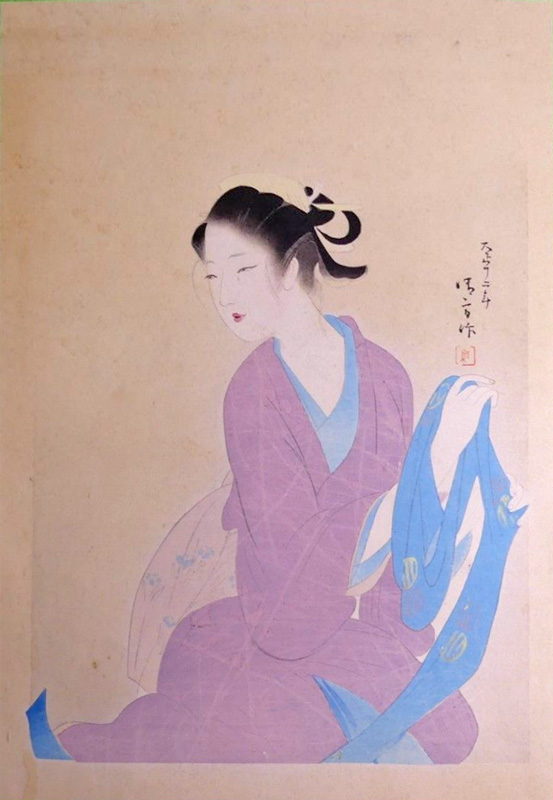About This Print
One of 18 prints published from 1922 to 1923 as part of the celebration of the two-hundredth anniversary of the death of Chikamatsu Manzaemon (1623-1724), perhaps the greatest dramatist in the history of the Japanese theater. Each design illustrates a scene or character from one of Chikamatsu’s famous works. For more details on this set of prints go to Woodblock Print Supplements to the Complete Works of Chikamatsu.In the print Osai, the wife of a tea ceremony teacher, who secretly longs for Sasano Gonza, her intended son-in-law, holds the sash she has just torn from Gonza after a struggle. The sash displays his crest and a reverse chrysanthemum joined in a lover's knot. After tearing off the sash she cries "Are you so devoted to that sash? Here, I know you won't like it, but wear my sash instead. It will become a vengeful snake, wrap itself around you waste, and never let you go."1 While jealous, she smiles sweetly, looking over her shoulder with a tender expression of affection. When Gonza throws her sash into the garden it is taken by the samurai Bannojō, hiding there, as proof of their adultery, the penalty for which is death.
There are at least two editions of each print in the series, with one edition bearing the names of the carver and printer for the series in the bottom margin as follows:
彫刻:山岸主計 手摺:西村熊吉 (Blockcutter: Chôkoku Yamagishi Kazue Printer: Tezuri Nishimura Kumakichi).
This collection's print does not have these markings.
Interestingly, one of the printings changed the color of Osai's kimono and added pattern details to it, as shown below.
1 The Major Plays of Chikamatsu, translated by Donald Keene, Columbia University Press, 1961, pg. 291.
The Story of Osai in Yari no Gonza kasane katabira (Gonza The Lancer)
Source: The Major Plays of Chikamatsu, translated by Donald Keene, Columbia University Press, 1961, pgs. 4, 312.Chikamatsu’s career as a dramatist probably began in 1683 when, at the age of thirty, he wrote the puppet play The Soga Successors for the chanter Uji Kaga-no-jo. The Soga Successors (Yotsugi Soga) was highly acclaimed, and the great chanter Takemoto Gidayu (1651-1714) used it to open his theater in Osaka in 1684.
First performed on September 26, 1717, Chikamatsu modeled this play on events which occurred about six weeks before the first performance, changing the names of the characters and moving the location of the final scene. He called the chief character Gonza, the hero of a half-century-old ballad.
The play's subtitle, "The Double Hempen Kimonos," places the action in summer and hints at Osai's double love life.
In the play, Osai, the wife of Ichinoshin, is unjustly accused of improper relations with her intended son-in-law Sasano Gonza, who she is secretly in love with. When they are accused of impropriety, Osai proposes to Gonza that they actually become lovers, ostensibly so that her husband Ichinoshin will have grounds for killing them, which he will do at the grisly end of the play, as related below by the play's narrator.
She [Osai] approaches Inchinoshin. With one hand he slashes her from hip to hip, and she topples on her face with a shriek. He grips her by the sash and lifts up her face. A look at her brings pity for his children; his breast floods with tears of wrath at this hateful, hateful, woman. He shakes off the thought and, driving his sword into her again, he pushes back her body. He stamps on her breast and thrusts his sword point deep into her vitals. Such is his fury that he slashed his own right foot from heel to sole, without realizing it. He turns at once to Gonza. Stamping on his chest, he deals the final thrust.
| IHL Catalog | #1730 |
| Title or Description | The Heroine Osai in Yari no Gonza kasane katabira 「鑓の権三重帷子」のおさい |
| Series | Woodblock Print Supplements to the Complete Works of Chikamatsu Dai Chikamatsu zenshu furoku mokuhan 大近松全集 付録木版 |
| Artist | Kaburaki Kiyokata (1878-1972) |
| Signature |  unread inscription in the right column. |
| Seal | unread red square artist's seal (see above) |
| Publication Date | between 1922-1923. Several sources date this print to 1923. |
| Edition | |
| Publisher | Dai Chikamatsu zenshū kankōkai 大近松全集刊行会 (the Complete Work of Chikamatsu Publishing Association) |
| Carver | Yamagishi Kazue 1893-1996 |
| Printer | Nishimura Kumakichi |
| Impression | excellent |
| Colors | excellent |
| Condition | good - hadnling creases; three horizontal lines (possibly from printing process) |
| Miscellaneous | all prints from this series printed on a light tan-colored paper |
| Genre | shin hanga (new prints) |
| Format | dai-oban |
| H x W Paper | 18 x 11 3/4 in. (45.7 x 29.8 cm) |
| H x W Image | 15 1/4 x 9 3/8 in. (38.7 x 23.8 cm) |
| Collections This Print | The Tsubouchi Memorial Theatre Museum of Waseda University 201-0226, 201-0372; The Museum of Fine Arts, Boston 48.739; Los Angeles County Museum of Art, M.71.100.40; Harvard Art Museums 1941.54; Freer Gallery of Art and Arthur M. Sackler Gallery S2003.8.419 |
| Reference Literature | The Female Image: 20th Century Prints of Japanese Beauties, Amy Riegle Newland and Hamanaka Shinji, Abe Publishing Ltd and Hotei Publishing, 2000, p. 95, pl. 122; The Pupils of Kaburaki Kiyokata: New Ukiyo-e from the Greater Taisho Period, Maureen de Vries, Chirs Uhlenbeck and Elise Wessels, Nihon no Hanga, 2012, pl. 7, p. 15. |
3/24/2019



